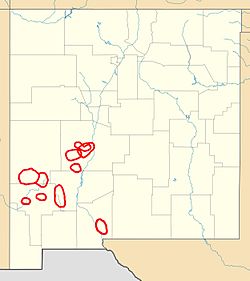Mogollon-Datil volcanic field facts for kids
Quick facts for kids Mogollon-Datil volcanic field |
|
|---|---|
| Highest point | |
| Geography | |
| Location | New Mexico, United States |
| Geology | |
| Age of rock | Middle Tertiary |
| Mountain type | Volcanic field |
The Mogollon-Datil volcanic field is a large (40,000 square kilometers (15,000 sq mi)) silicic volcanic field in western New Mexico (Mogollon Mountains-Datil, New Mexico). It is a part of an extensive Eocene to Oligocene volcanic event which includes the San Juan volcanic field in southwestern Colorado, the Trans-Pecos volcanic field in west Texas and north central Mexico, the Boot Heel volcanic field in the bootheel of southwestern New Mexico and adjacent areas of Arizona and Mexico; and the vast volcanic field of the Sierra Madre Occidental of western Mexico. The Mogollon-Datil volcanic field was formed in "four discrete pulses representing synchronized activity of two separate cauldron complexes".
Formations
The stratigraphic framework for the Mogollon-Datil volcanic field has undergone many revisions. The Datil Formation was originally defined by Winchester in 1920 to include all the extrusive units from the field. The Datil Formation was later promoted to group rank with the addition of some related sedimentary formations, such as the Baca Formation and the Spears Formation. The base of the group, as originally defined, rests unconformably on the Mesaverde Formation, and the series is succeeded by the Popotosa Formation of the Santa Fe Group.
The stratigraphic framework proposed by Cather, Chamberlin, and Ratte in 1994 divides the units associated with the Mogollon-Datil volcanic field into three groups and removes the Baca Formation:
| Volcanic Units | Sedimentary Units | ||
|---|---|---|---|
| Mogollon Group |
tuff of Turkey Springs |
Spears Group |
South Crosby Peak Formation |
| lacuna (31.4-29.0 Ma) | |||
| Datil Group |
Tadpole Ridge Tuff |
||
Cather, Chamberlin, and Ratte find that the Alum Mountain Formation in the southern part of the field may span the lacuna between the Mogollon and Datil Groups, though they suggest a tentative assignment to the Mogollon Group. Still further south, voluminous volcanic activity in northern Chihuahua took place in this time period and no lacuna exists.
Clasts of the Vicks Peak and La Jencia Tuffs have been found in the gravel beds of the Benavidez Member of the Cerro Conejo Formation in the Rio Puerco valley west of Albuquerque. These suggest that the outflow sheets of the Datil-Mogollon volcanic field reached as far north as the northern edge of the younger Mount Taylor volcanic field, where they interfingered with the Chuska Sandstone and with cherty gravels eroded off the Zuni Mountains. This outflow sheet was subsequently completely eroded away north of the Rio Salado.
Notable Calderas
Northern complex
Socorro-Magdalena caldera cluster
Location: West of Socorro, South of Magdalena, and Southeast of Datil.
| Name | Associated tuff | Coordinates | Age |
|---|---|---|---|
| Socorro Caldera | Hells Mesa Tuff | 34°00′N 107°06′W / 34°N 107.1°W | 32 Ma |
| Sawmill Canyon Caldera | La Jencia Tuff | 34°00′N 107°18′W / 34°N 107.3°W | 28.7 Ma |
| Hardy Ridge Caldera | Lemitar Tuff | 33°54′N 107°18′W / 33.9°N 107.3°W | 28 Ma |
| Mount Withington Caldera | South Canyon Tuff | 33°48′N 107°30′W / 33.8°N 107.5°W | 27.4 Ma |
| Bear Trap Caldera | tuff of Turkey Springs | 33°45′N 107°36′W / 33.75°N 107.6°W | 24.3 Ma |
Southern complex
Located from Las Cruces to Mogollon:
| Name | Associated tuff | Coordinates | Age |
|---|---|---|---|
| Nogal Caldera | Vicks Peak Tuff | 33°36′N 107°24′W / 33.6°N 107.4°W | 28.4 Ma |
| Organ Caldera |
Cueva Tuff |
32°30′N 106°45′W / 32.5°N 106.75°W | 32 Ma |
| Emory Caldera | Kneeling Nun Tuff Fall Canyon Tuff |
33°00′N 107°45′W / 33°N 107.75°W | 33 Ma |
| Twin Sisters Caldera | Tadpole Ridge Tuff Caballo Blanco Tuff |
33°00′N 108°15′W / 33°N 108.25°W | 31.4 Ma |
| Schoolhouse Mountain Caldera | – | 32°45′N 108°36′W / 32.75°N 108.6°W | 33.5 Ma |
| Mogollon Caldera (just one fragment in the Bursum Caldera wall) |
Cooney Tuff Fanney Rhyolite Apache Springs Tuff |
33°30′N 108°30′W / 33.5°N 108.5°W | 34.0 Ma |
| Bursum Caldera | Bloodgood Canyon Tuff | 33°30′N 108°30′W / 33.5°N 108.5°W | 28.0 Ma |
| Gila Cliff Dwellings Caldera | Davis Canyon Tuff Shelley Peak Tuff |
33°30′N 108°15′W / 33.5°N 108.25°W | 28.1 Ma |
Note: the ages given in Chapin et al. (2004) and Ward (2009) do not match sometimes.


